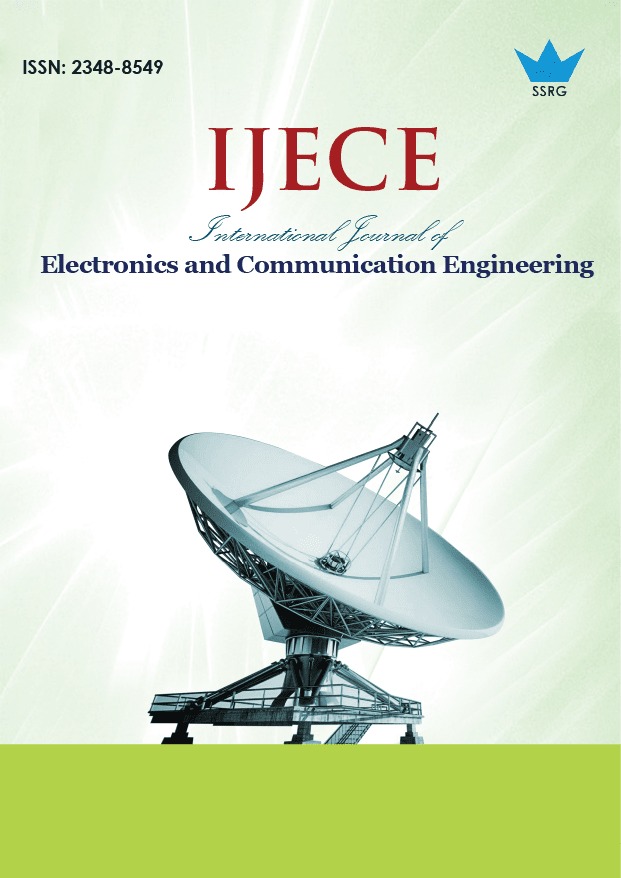Design and Comparative Analysis of Biosensing Devices with Different Dielectric Materials for Blood Cancer Detection

| International Journal of Electronics and Communication Engineering |
| © 2025 by SSRG - IJECE Journal |
| Volume 12 Issue 5 |
| Year of Publication : 2025 |
| Authors : Sankararao Majji, Chandra Sekhar Dash, Asisa Kumar Panigrahy |
How to Cite?
Sankararao Majji, Chandra Sekhar Dash, Asisa Kumar Panigrahy, "Design and Comparative Analysis of Biosensing Devices with Different Dielectric Materials for Blood Cancer Detection," SSRG International Journal of Electronics and Communication Engineering, vol. 12, no. 5, pp. 227-235, 2025. Crossref, https://doi.org/10.14445/23488549/IJECE-V12I5P120
Abstract:
The healthcare industry is constantly changing due to technological breakthroughs that spur new methods of diagnosing and treating illnesses. In this study, we suggested a novel structure for a label-free biosensor that senses both charged and neutral bioanalytes: the dielectric modulated dual-dielectric Ion-Sensitive Field Effect Transistor. Compared to Nanosheet FET (NSFET), the ISFET device shows better bio-sensing ability. Al2O3 oxide is substantially more sensitive than other oxides when pH 7.4 is considered. The resulting 2D-ISFET has the potential to be a rapid blood cancer screening tool due to its exceptional blood electrolyte sensitivity. The findings demonstrate that the ISFET has reduced Subthreshold Swing (SS), Increased ON-current (ION) and switching ratio, and drain-induced barrier lowering. The recommended apparatus and the pH sensor's sensitivity may identify blood cancer indicators as high as 30 fg/mL. A significant advancement in technology-driven healthcare is using ISFET sensors for DNA-based blood cancer detection. This creates new opportunities to enhance patient outcomes and cancer diagnosis. Its excellent sensitivity, selectivity, low detection limit, thermal stability, biocompatibility, and affordability make it a promising material for a wide range of flexible sensing applications in the future. In our work, we have mainly focused on blood cancer detection. The proposed biosensors signify a significant advancement in technology-driven healthcare, offering new possibilities for enhancing cancer diagnostics and patient outcomes.
Keywords:
ISFET sensors, NSFET, Blood cancer, Dielectric materials, Al2O3, PVP.
References:
[1] Ning Gu, and Shaoqin Liu, “Introduction to Biosensors,” Journal of Materials Chemistry B, vol. 8, no. 16, pp. 3168-3170, 2020.
[CrossRef] [Google Scholar] [Publisher Link]
[2] Chloé Albert-Vega et al., “Immune Functional Assays, From Custom to Standardized Tests for Precision Medicine,” Frontiers in Immunology, vol. 9, pp. 1-12, 2018.
[CrossRef] [Google Scholar] [Publisher Link]
[3] Amit M. Joshi, Prateek Jain, and Saraju P. Mohanty, “Everything You Wanted to Know About Continuous Glucose Monitoring,” IEEE Consumer Electronics Magazine, vol. 10, no. 6, pp. 61-66, 2021.
[CrossRef] [Google Scholar] [Publisher Link]
[4] Naixiang Wang et al., “Functionalized Organic Thin Film Transistors for Biosensing,” Accounts of Chemical Research, vol. 52, no. 2 pp. 277-287, 2019.
[CrossRef] [Google Scholar] [Publisher Link]
[5] Chenfang Sun et al., “Organic Thin Film Transistors-Based Biosensors,” EcoMat: Functional Materials for Green Energy and Environment, vol. 3, no. 2, pp. 1-22, 2021.
[CrossRef] [Google Scholar] [Publisher Link]
[6] Anneng Yang et al., “Fabric Organic Electrochemical Transistors for Biosensors,” Advance Materials, vol. 30, no. 23, 2018.
[CrossRef] [Google Scholar] [Publisher Link]
[7] Xudong Ji et al., “Smart Surgical Catheter for Cre-active Protein Sensing Based on an Imperceptible Organic Transistor,” Advance Science, vol. 5, no. 6, pp. 1-8, 2018.
[CrossRef] [Google Scholar] [Publisher Link]
[8] Shanshan Cheng et al., “Label-Free Detection of Tumor Markers Using Field Effect Transistor (FET)-Based Biosensors for Lung Cancer Diagnosis,” Sensors and Actuators B: Chemical, vol. 212, pp. 329-334, 2015.
[CrossRef] [Google Scholar] [Publisher Link]
[9] Clementine M. Boutry et al., “Biodegradable and Flexible Arterial-Pulse Sensor for the Wireless Monitoring of Blood Flow,” Nature Biomedical Engineering, vol. 3, pp. 47-57, 2019.
[CrossRef] [Google Scholar] [Publisher Link]
[10] Alessandra Campana et al., “Electrocardiographic Recording with Conformable Organic Electrochemical Transistor Fabricated on Resorbable Bioscaffold,” Advanced Materials, vol. 26, no. 23, pp. 3874-3878, 2014.
[CrossRef] [Google Scholar] [Publisher Link]
[11] H.C. Ananda Murthy et al., 17 - Polymer Composites for Electrochemical Sensor Applications, Polymeric Nanocomposite Materials for Sensor Applications, Elsevier Science, pp. 405-436, 2023.
[CrossRef] [Google Scholar] [Publisher Link]
[12] Ajay Kumar, Amit Kumar Goyal, and Neha Gupta, “Review—Thin-Film Transistors (TFTs) for Highly Sensitive Biosensing Applications: A Review,” ECS Journal of Solid-State Science and Technology, vol. 9, no. 11, pp. 1-12, 2020.
[CrossRef] [Google Scholar] [Publisher Link]
[13] Dawit Burusie Abdi, and M. Jagadesh Kumar, “Dielectric Modulated Overlapping Gate-on-Drain Tunnel-FET as a Label-free Biosensor,” Superlattices and Microstructures, vol. 86, pp. 198-202, 2015.
[CrossRef] [Google Scholar] [Publisher Link]
[14] R. Rios et al., “Comparison of Junctionless and Conventional Trigate Transistors with Lg Down to 26 nm,” IEEE Electron Device Letters, vol. 32, no. 9, pp. 1170-1172, 2011.
[CrossRef] [Google Scholar] [Publisher Link]
[15] Anuj Chhabra, Ajay Kumar, and Rishu Chaujar, “Sub-20 nm GaAs Junctionless FinFET for Biosensing Application,” Vacuum, vol. 160, pp. 467-471, 2019.
[CrossRef] [Google Scholar] [Publisher Link]
[16] Narendra Kumar et al., “Role of Deposition and Annealing of the Top Gate Dielectric in a-IGZO TFT-Based Dual-Gate Ion-Sensitive Field-Effect Transistors,” Semiconductor Science and Technology, vol. 32, no. 3, 2017.
[CrossRef] [Google Scholar] [Publisher Link]
[17] Lemeng Chao et al., “Recent Advances in Field Effect Transistor Biosensor Technology for Cancer Detection: A Mini Review,” Journal of Physics D: Applied Physics, vol. 55, no. 15, pp. 1-15, 2021.
[CrossRef] [Google Scholar] [Publisher Link]
[18] Fernando Patolsky, and Charles M. Lieber, “Nanowire Nanosensors,” Materials Today, vol. 8, no. 4, pp. 20-28, 2005.
[CrossRef] [Google Scholar] [Publisher Link]
[19] Jun-Sik Yoon et al., “Multi- Vth Strategies of 7-nm Node Nanosheet FETs with Limited Nanosheet Spacing,” IEEE Journal of the Electron Devices Society, vol. 6, pp. 861-865, 2018.
[CrossRef] [Google Scholar] [Publisher Link]
[20] Meng-Hsueh Chiang, Cheng-Nang Lin, and Guan-Shyan Lin, “Threshold Voltage Sensitivity to Doping Density in Extremely Scaled MOSFETs,” Semiconductor Science and Technology, vol. 21, no. 2, 2006.
[Google Scholar] [Publisher Link]
[21] Genius: 3-D Device Simulator, Cogenda, 2008. [Online]. Available: https://www.cogenda.com/article/Genius

 10.14445/23488549/IJECE-V12I5P120
10.14445/23488549/IJECE-V12I5P120